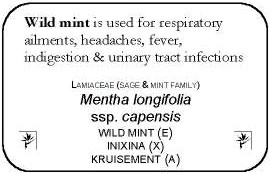The Useful Plants Garden
28 November 2003
A garden featuring 150 indigenous plants with a wide range of traditional uses was officially opened at Kirstenbosch in the Western Cape on Tuesday.
The Useful Plants Garden is the brainchild of current Kirstenbosch scholar Phakamani Xaba, who started the project in February last year and was funded by the Botanical Society of South Africa and the Rowland & Leta Hill Trust.
The garden focuses on plants commonly used in southern Africa, especially those that have become rare or endangered through exploitation for medicinal uses or by competition from exotic crops.
It is divided into sections according to the plants' different uses: cereal plants and vegetables; construction; erosion control; crafts and weaving; dyes plants; charm plants; plants used for sexually related problems, stomach ailments, to repel insects and to treat snake-bites; headache remedies and plants used to treat colds, coughs and flu.
Speaking at the launch, Environmental
Affairs and Tourism Deputy Minister Rejoice Mabudafhasi said the Useful Plants Garden would raise awareness among the public - particularly young South Africans - about the conservation of indigenous plants.
"Because the project was started by a young person, it will help educate other young people about the importance of their culture and to care for their environment and resources", Mabudafhasi said.
Mabudafhasi added that the Useful Plants Garden had taken gardening to another level, where it formed a part of people's everyday lives.
Xaba said the garden was based on centuries of plant use knowledge from all the peoples and cultures of South Africa.
"We want to use the garden to educate the general public about useful indigenous plants and to get communities involved in the development of indigenous crops and the preservation and conservation of threatened medicinal plants", Xaba said.

Each individual plant grouping is labelled with interesting information, and visitors can safely handle, touch, rub and smell all the plants.
The garden also boasts a traditional Xhosa/Mpondo hut, used to display examples of objects made from some of the plants on display, as well as interpretive information about the plants and the construction of the hut.
A satellite Useful Plants Garden has also been established at the Edith Stephens Wetland Park in Philippi.
Source: BuaNews



